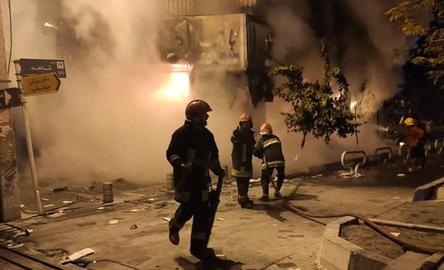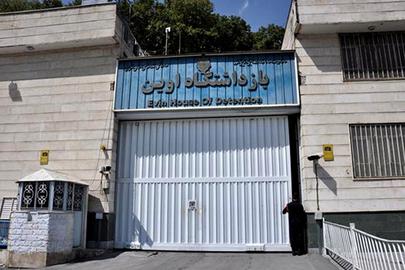The Revolutionary Guards Corps has publicly outlined the tactics it uses to suppress public protests. Some of them, which a new article refers to as "controlling subversive collective actions," will be recognizable to Iranians who took part in nationwide protests in November 2019, and particularly to those who were targeted by security forces' bloody response.
***
The tactics the Revolutionary Guards use to suppress public protests have been outlined in an article published in the quarterly publication Afagh-e Amniat [Security Horizons], which is affiliated with the Imam Hossein University run by the Guards. These tactics were used against protesters over the last three years, and in particular during the brutal suppression of demonstrations in 2019.
Figures for the number of people killed by law enforcement, security forces and intelligence agents during the November 2019 protests against increased gas prices differ substantially. One media report cited it as 250 deaths; another put the number at 1500.
As the first anniversary of the bloody repression approaches, Iranian authorities, from the most senior leaders to bottom-rank officials, refuse to take responsibility for these deaths. Not only that, but they continue to punish protesters, issuing heavy sentences against them, and in some cases, even death sentences.
Over the last year, there has been no sign of remorse for this violence, and the perpetrators of the suppression have not been sent to trial or been held accountable. At the same time, the atmosphere in Iran has become more like a police state, with security forces becoming more of a daily presence everywhere.
During the last year, fewer protest rallies have been allowed, and most of them have been dealt with severely. The regime’s treatment of protesters has become more agitated and violent. As dissatisfaction among the population rises, especially in response to the deepening economic problems, Iranian authorities have identified a worsening security threat in the country, and this is how they justify their heavy-handed shifts in policy that suppresses any public criticism before it can be voiced.
Although this policy has been somewhat successful, in many cases it has also sparked more protests and it can be argued that it has increased social pressure that has been hidden like a dormant volcano, and which could erupt at any time.
The recent article published in Afagh-e Amniat, entitled “The Future of Controlling Subversive Collective Action with an Emphasis on Urban Unrest,” discusses ways to control social actions such as strikes, rallies, petitions, women not wearing hijab according to the guidelines, social unrest, civil dissidence, all of which, it says, "target the values and norms of the Islamic Republic."
The study, after a long introduction of defining and explaining the forms and roots of subversive collective actions, concedes that the clergy, professors, and well-known personalities in Iran no longer have any authority in the eyes of the people, as they did in the 1980s.
Following this admission, the study investigates the power of social networks in mobilizing the public in Iran, and implicitly presents the November 2019 protests as the result of these networks’ performance.
This study highlights the key factors that reinforce and strengthen subversive collective actions in Iran, saying these have been ushered in by "the trend of increasing false sects and mysticism;” "increasing identity and ethnic demands;” "increasing emerging harms;” and "increasing opportunities and challenges of social networks to mobilize resources and activist forces."
Another hallmark of the report is the acknowledgment that "people's changing identities and lifestyles have increased distrust in the political system.”
A Move From "Hard" to "Soft" Strategies
The study also hypothesizes that "the rapid, uneven, and uncontrollable growth of social networks will lead to the emergence of new areas of collective urban action (quiet, semi-quiet, and restless) in the future; this will accelerate the process of transforming collective action, from unionism to collective action and from collective action to security threats, which consequently complicate their control."
The second hypothesis the article sets out is based on the theory that "people's information and demands will increase and the government and the system is not able to respond adequately despite the increase in the level of services and welfare. Controlling these actions in the future will not be limited to the area of the counterinsurgency unit, but their control must change from hard strategies to soft and smart strategies."
In its third hypothesis, the research states that "the effective presence of certain figures (in sports and art, etc.) inside and outside the country in the political and social arenas will play a very important role in guiding or controlling collective actions. Confronting the intellectual and behavioral waves created by celebrities in society, we must also think of a new model or mechanism of collective control and guidance."
After formulating these hypotheses, the article concludes: "the management and control of urban unrest is different from what it has been in the past. Collective action seems to have moved beyond physical and violent actions and have become more like waves: soft, virtual, and invisible reactions."
The Revolutionary Guards’ report also concludes: "Competition for control of the thoughts and minds of the people will be the most important factor in future collective actions, and certainly the best way to control these actions should be based on soft control and influence on the minds and thoughts of the people in order to defeat the enemy.
"An important and effective way of countering violent acts of subversive violence is showing authority and demonstrating power through the use of non-lethal and powerful police equipment, such as deterrent weapons and modern police tools," the report says.
There is no doubt that the repressive machine of the Islamic Republic has implemented much of what it has set out in its agenda. The suppression of protests over the last three years, and in particular the bloody violence against protesters in November 2019, were carefully planned, and officials have deployed new tools and methods of repression over the last three years, culminating in the bloody massacres of November 2019. It’s just one of many bitter consequences of such a repressive and extensive set of policies.
visit the accountability section
In this section of Iran Wire, you can contact the officials and launch your campaign for various problems



























comments